The Nov. 2007 Trains Magazine Haulin’ has an article about trains hauling gas in tank cars on Montana Rail Link, called “Haulin’ Gas”. The train “had the requisite tool/idler boxcar and 20 tank cars”. What is an idler car, and why is it needed?
An idler car is an empty car, on which no part of a load rests, that is used in transporting freight of unusual length or excessive weight for the safe transportation or protection of lading.
Why would it be included on a regularly scheduled run of 20-30 tanks cars?
I’ve seen the term idler car used in relation to hazardous cargo or lading that might shift in transit to protect the train crew. In one instance, a long train of large diameter pipe enroute to a Canadian natural gas pipeline project via the Southern Pacific had an empty boxcar between the locomotives and first flat containing pipe, and there was another empty boxcar at the rear between the pipe and a caboose. These were to protect the crew members at both ends from shifting pipe.
In the case of a highly explosive gas, an idler car is not going to offer very much protection, so there may be a different reason for having one.
Actually I think idler is the wrong term. An idler as previously mentioned bears no part of the load but is required because of length9 ie: overhang from adjacent car. A carplaced to protec the crew is called " cover" on roads where I have taked to the crew about it. I understand some require as many as 3 cars between hazardous materials and the locomotive. It’s my understanding that a shipper pays for an idler but not for “cover”.
As a cover car…the FRA requires at least one non hazardous car between the locomotive and any hazardous loaded car…five non hazardous cars if available or depending on what the hazardous car contains.
See UPs form 8620…placement in train chart.
“Cover” cars are referred to in form 8620 as buffer cars.
MRL gets away with one because gasoline is a combustible, not a flammable liquid, and with combustibles all you need is one cover car.
In fact, an empty combustible car is considered a cover car.
Shiftable loads, like pipe or machinery also need cover cars…for pipe in gons, if it is loaded below the top of the car, no cover is needed, loaded above the top, it becomes a shiftable and needs cover.
And, as the story pointed out, they often haul spot cars on the head end for the local to work, so they have cover there.
Idler or spacer cars are used to distribute weight…but the terms…idler, spacer, buffer or cover cars are often interchangeable.
The idea is to separate the locomotive and crew from the hazardous material by at least one car, in case of an accident.
Well…There you have it. It’s a safety buffer for the train crew.
csx calls em buffer cars…rule book dated 2001 says 3 buffer cars between “occupied” engine or caboose and a haz-mat load…3 units (engines) means ya need 1 buffer car between you and that first tank car filled with die-killa-explodo-evacuate 2.5.4…theres numorous others also…must have a bulkhead car hauling pipeor a buffer car between flat loaded with pipe and an occupied engine/caboose…etc etc
Generally, cars used to separate hazmat or shiftable loads from each other or the engine/caboose are called buffer or cover cars.
The Eastern HAZMAT code requires 5 buffer cars between the engine and most loaded HAZMAT tank cars or any type car of certain hazmat classes. In the event 5 cars aren’t available, you need are required to have every available buffer car between the engine and the HAZMAT. In any event, there must be at least 1 buffer car.
While you can make the argument the unoccupied locomotives count as buffers, you won’t get far with the FRA, because any locomotive in the consist has the possibility of being occupied. It is the opinion of the FRA that there must the required number of buffer cars between the locomotive consist and the HAZMAT.
Idler cars, usually refer to cars used to provide spacing for oversize or weight cars, or cars used as a “handle” to move other cars that a locomotive is unable to reach.
Nick
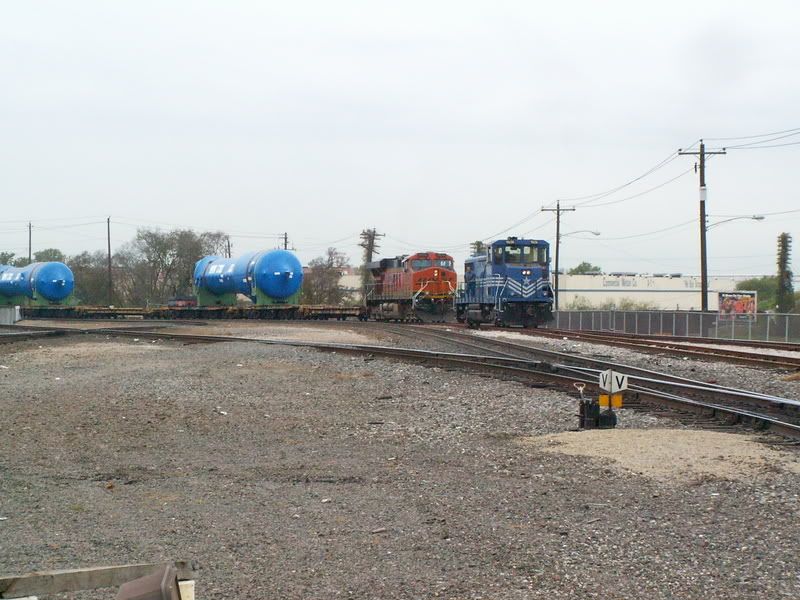
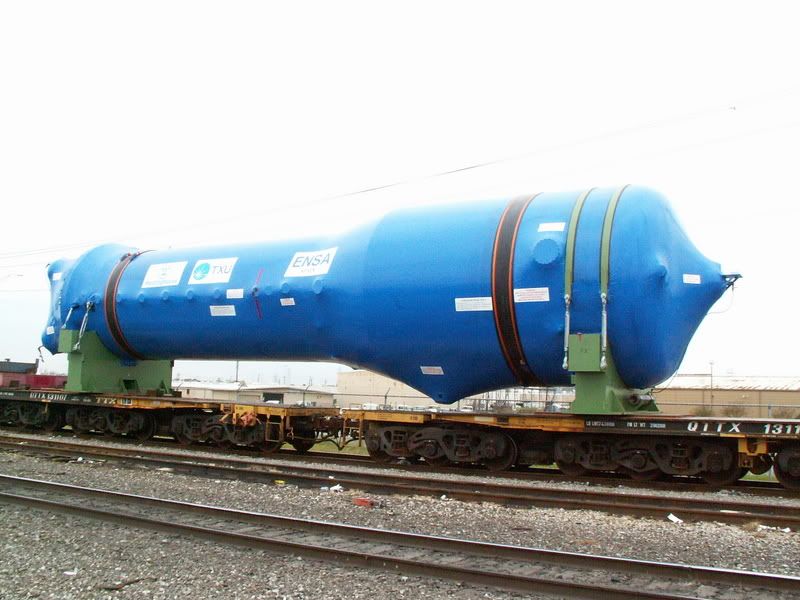
Idler cars in use.
Because the turbines are longer than the flat cars, they use two flats per turbine, with a idler, or empty car in between.
The reason is twofold…to keep the turbines from hitting each other, and because two of the turbines together weigh more then some of the bridges they will cross are rated for…the spacer or idler car distributes the weight over a larger area.
See if this helps you out some…
UP Form 8620, effective 0001 Sunday, June 18, 2006.
Note that gasoline is a class 3, placard is the red one with the 3…diesel is the red and white placard, class 3, also in column A.
The need for the one cover car in the story is simply for safety, a precaution in case of a derailment or collision.
Note in the general instruction, page 39, section C for a definition of a buffer or “cover” car.
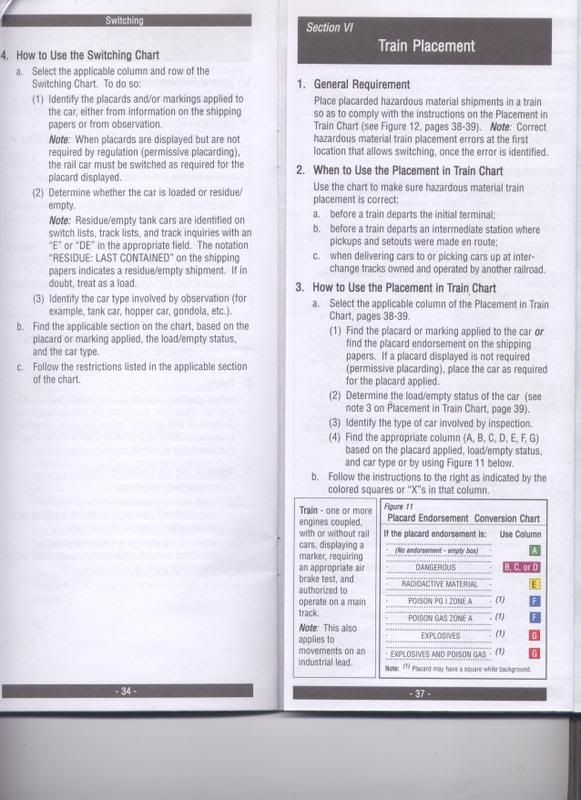
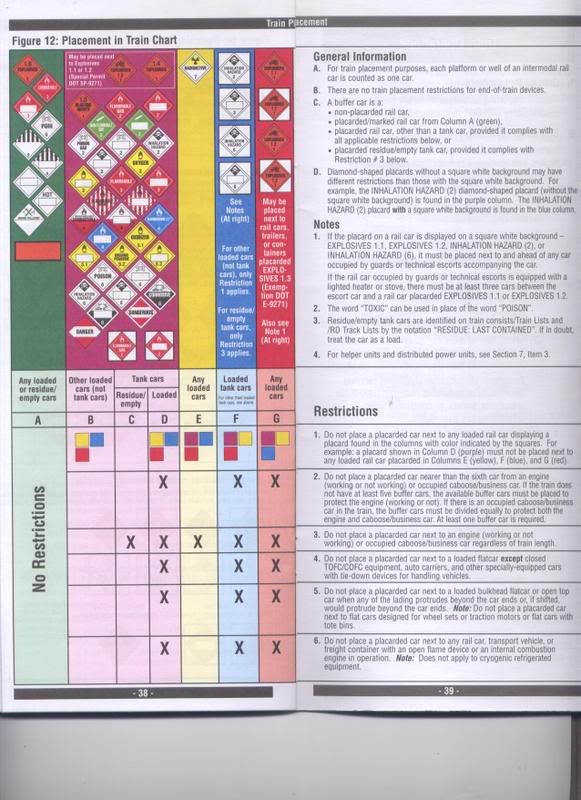
From Ed Blysard’s reply:
“The reason is twofold…to keep the turbines from hitting each other, and because two of the turbines together weigh more then some of the bridges they will cross are rated for…the spacer or idler car distributes the weight over a larger area.”
One of the recent issues of TRAINS had a picture of GE Loco’s in Chile that were seperated by a caboose that was specially equipped to run between two MU’d locomotives. The reason given was an issue of weight distribution for low weighted bridges or track.
Southern Rwy, and later Norfolk Southern has a line in, I think South Carolina, that has a specific bridge that has a low weight issue; their answer is to run a specially equipped boxcar with provisions for Multiple Unit use between the locomtives as a spacer/buffer/etc. I remember a photo of this setup in TRAINS, as well.
With extra trucks in the center of car, how does it negotiate tight curves?
You are correct. The Southern/NS has a local that runs from Blacksburg, SC to Shelby, NC that uses two GP38s separated by a now ancient boxcar built for that purpose.
What’s the difference between combustible and flammable? Either one sounds like toasted marshmallows, if something goes wrong.
In simplest terms, combustible has a flash point over 100 degrees, flammable below 100 degrees, and flammables are usually liquids. IIRC, road tar is a combustible, as it will burn…
Here’s a hazmat definition of combustible which includes a link to flammable…
…To try to answer Spokyone’s question with “extra trucks in the center” how does it negotiate tight turns.
Believe each special flat car that has these special "double truck assemblies at each end of the car relies on a special frame connecting each set of trucks together and each truck fastened to that frame by a pivot pin. Then the top of said special frame is connected to the underbody of the flat car by another pivot pin. This arrangement allows each “truck” to follow the curve alignment.
As a cover car…the FRA requires at least one non hazardous car between the locomotive and any hazardous loaded car…five non hazardous cars if available or depending on what the hazardous car contains.
See UPs form 8620…placement in train chart.
“Cover” cars are referred to in form 8620 as buffer cars.
MRL gets away with one because gasoline is a combustible, not a flammable liquid, and with combustibles all you need is one cover car.
In fact, an empty combustible car is considered a cover car.
Shiftable loads, like pipe or machinery also need cover cars…for pipe in gons, if it is loaded below the top of the car, no cover is needed, loaded above the top, it becomes a shiftable and needs cover.
And, as the story pointed out, they often haul spot cars on the head end for the local to work, so they have cover there.
Idler or spacer cars are used to distribute weight…but the terms…idler, spacer, buffer or cover cars are often interchangeable.
The idea is to separate the locomotive and crew from the hazardous material by at least one car, in case of an accident.
Ed,
I think it was you who posted some pictures of Schnabel cars being loaded or leaving your area. If memory serves there were some idler cars between. Were these for protection or for weight issues. I thought there was another picture that had 3 or 4 idler cars between do to bridge loading issues.
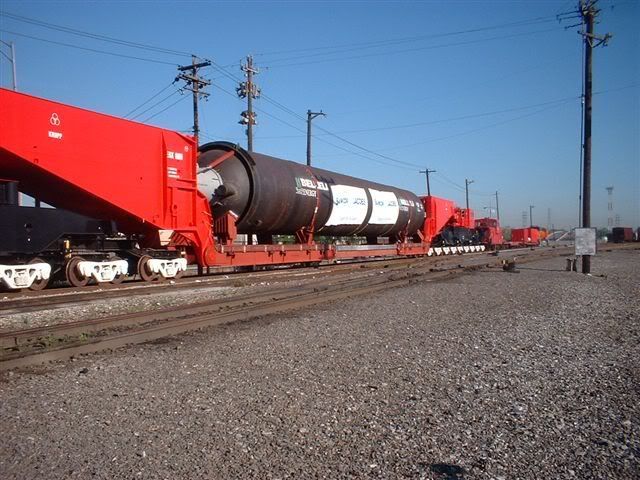
This one?
And yes, the flat car is there for both reasons.
This one also has the idler cars to distribute the weight.

See if this helps you out some…
UP Form 8620, effective 0001 Sunday, June 18, 2006.
Note that gasoline is a class 3, placard is the red one with the 3…diesel is the red and white placard, class 3, also in column A.
The need for the one cover car in the story is simply for safety, a precaution in case of a derailment or collision.
Note in the general instruction, page 39, section C for a definition of a buffer or “cover” car.
I think gasoline us under flammable liquids. The placard on page 46 of the article shows a red diamond with a white box, and I think the number 3. That is clearly in column D of the purple area. A red diamond with a white box and the number 2 is in the same column. The white boxes are where identification numbers go.
If it was under column A loaded or empty, there are NO restrictions on placement. It could be next to the engine.
Loaded tank cars under column D in the purple area must not be next to any engine, working or not. It also can’t be next to rail cars that have working internal combustion engines, Mechancial Reefers for example. It must not be nearer than the sixth car from the engines, working or not. However, if there aren’t 5 cars in the train than are suitable to be used as buffer cars in the train, use the available ones to separate the engines, working or not, and the restricted car(s). At least one buffer car must used. (There are also other restrictions I didn’t mention.) I think the main reason isn’t for crew protection, but to keep these loads from possible ignition sources.
The Gas Local, and a lot of ethanol unit trains are made up with one buffer car.